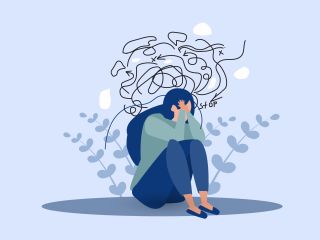Unconscious
Accept the Gift of Consciousness—Choice
You must first transcend the curse of consciousness.
Updated November 8, 2023 Reviewed by Hara Estroff Marano
Key points
- Your unconscious brain is on constant alert (anxiety) and gives you the gift of life.
- Survival signals are often interpreted by your conscious brain as repetitive unpleasant thoughts (RUTs).
- Fighting off RUTs is a losing battle, wears you down, and keeps you in a reactive state.
- To access the gift of consciousness (choice) you must separate your identity from your survival reactivity.
Anxiety is the “gift of life,” created by sensations from the nervous system operating below the level of awareness. Every living creature, from one-cell organisms to mammals, processes input from its surroundings to navigate challenges in order to, first, remain alive and, second, to pass its genetic material to the next generation.
The nervous system processes input from outside the body (exteroception) and from sensations arising from within (interoception). Nervous circuitry evolved as the complexity of organisms required, and central nervous systems gradually emerged. Language is a recent development that has allowed homo sapiens to cooperate, physically thrive, and engage in complex abstract thinking.
“The gift of the unconscious “– life
Your nervous system constantly receives signals from all your internal organs that dictate responses in order to avoid threats and gravitate towards feeling safe. Hunger, thirst, fatigue, full bowel and bladder, and low blood pressure belong to a long list of such internal signals coursing through the interoceptive nervous system.
Signals of safety are equally strong and exist in a delicate dynamic balance with the warning system. For instance, when you have finished a satisfying meal, you feel great and stop eating.
Finely tuned as the balance is, signals must be intense enough to compel immediate reactions to reduce threats and seek safety. Since survival is clearly the primary need, the system is biased toward unpleasant sensations, and they are more frequent. The action of the nervous system with these internal signals gives rise to consciousness. But the incredibly powerful, complex signaling, operating unconsciously, can be considered the “gift of life.”
The curse of cognitive consciousness
Language allows us to possess cognitive consciousness and the capacity to describe the sensations we have. Meaning is given to the feelings generated by physiologic activity reflecting danger and safety. Because we are always on some degree of alert for trouble, we are inclined to an endless stream of unpleasant thoughts)—repetitive unpleasant thoughts, or RUTs.. Since the physiology that affects the nervous system also affects every cell in your body, the unpleasantness can be all-encompassing, feel like who you are, and become a core part of your identity. Tthe “gift of life” translates into the “curse of cognitive consciousness.”
Our brains become inflamed and hyperreactive, with excitatory neurotransmitters and inflammatory cells when in flight-or-fight physiology. Humans describe the sensations generated by an activated threat response as “anxiety" and "anger.” But they are physiologic states, not psychological. ones.1,2 Blood flow in the brain shifts from the neocortex (thinking centers) to the limbic system (fear and survival regions), so you cannot think as clearly when under real or perceived stress. An inflamed brain fires up even more RUTs, which are also perceived as dangerous, and there is no end to the cycle.

While we have an automatic withdrawal response (nociceptive system) for acute physical pain, there is no such response for mental pain. Suppressing RUTs only fires up threat physiology more and generates more RUTS. There is no end to this loop, and we have no protection from mental pain.3
We attempt to create good thoughts from our conscious brain to counter the distressing thoughts. But it's an impossible task, as the unconscious brain remains fired up and spewing "bad" thoughts. Cognition requires conscious mental effort, consumes energy, is a gross mismatch of power, and is not sustainable. The unconscious brain processes between 20 and 40 million bits of information per second, our conscious brain only about 40 per second. As a result, RUTs are common, miserable for many, and often have severe consequences.
Consequences of RUTs
One consequence is that well-intentioned people are especially affected and may view themselves negatively because such thoughts are a stark contrast to who they perceive themselves to be or what they stand for, . They don’t realize that the repetitive thoughts are interpretations of feelings generated from the unconscious brain. Efforts to combat RUTs often border on heroic, but the fallout is that people who potentially could significantly contribute to the common good are often crippled by anxiety (threat physiology), or they just get worn down.
Less well-intentioned people may simply act out such thoughts and impulses without a lot of self-judgment. Hence, history is replete with tyranny and control. There is actually a physiological reward for power and control. For example, bullies have been documented to have lower inflammatory markers than average, whereas those who have been subjected to being bullied have higher inflammatory markers.4
Not only do we humans expend a lot of energy fighting bad thoughts with good ones, but we also create “stories” to feel better about ourselves. We call it ego, self-esteem, or identity. As the powerful unconscious brain continues to keep us alive regardless of what we think or feel, there is no end to our efforts to create an identity that is bulletproof.
Another, more primitive solution is exerting power and control based on such stories. The solution to anxiety is control, but without a way of decreasing RUTs, there is also no limit to what we do to control ourselves and others. The stories are often the basis evil actions. Once we label someone or a group of people as “less than,” we can justify any action in order to bring them in line—even exterminating them. Labels are cognitive distortions that destroy awareness of details and, often, the needs of others.5,6
The gift of cognitive consciousness: choice
Any time you are anxious or frustrated, you are reacting to something that was perceived as dangerous from the past. You are no longer in the present and cannot clearly see the details of the situation in front of you. You can will your way back to neutral or better for periods of time. But you have now lost choice, which is the gift of consciousness. It is truly a gift in that you can take advantage of the physiologic e capacity for neuroplasticity to create any brain (and reality) that you wish. But you cannot access it while you feel under threat. It is simply not possible.
The gift of our unconscious is life, and it keeps us alive at any cost. RUTs reflect this effort and are the curse of cognitive consciousness. Separating our identity from them and regulating our physiology from threat to safety allows us to access the gift of consciousness, which is choice.
There are no shortcuts. You must separate your identity from your survival reactions with awareness to create choices. You are letting go in order to proactively move forward into creating the brain (neuroplasticity) and life you desire . Our lives can and will transform from reactive to creative.

The human race is a reactive species that knows how to physically survive. We have choice but can’t seem to access it with enough regularity to proactively create a thriving life and planet. Awareness allows choice and is where mental and physical healing begin.
References
1. Teed AR, et al. Association of generalized anxiety disorder with autonomic hypersensitivity and blunted ventromedial prefrontal cortex activity during peripheral adrenergic stimulation. JAMA Psychiatry (2022); doi:10.1001/jamapsychiatry.2021.4225
2. Takahashi A, et al. Aggression, social stress, and the immune system in humans and animal models. Front. Behav. Neurosci. (2018); 12:56. Doi: 10.3389/fnbeh.2018.00056
3. Wegner, DM. Ironic processes of mental control (1994); 101:34-52.
4. Copeland W, et al.” Childhood bullying involvement predicts low-grade systemic inflammation into adulthood.” PNAS (2014); 111: 7570-7575.
5. Burns, David. Ten Days to Self-Esteem. Harper Collins, New York, 1993.
6. De Mello, Anthony. The Way to Love: The Last Meditations of Anthony De Mello. Doubleday, New York, NY,1992.




